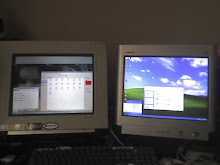Update 12-26-2019: I am using a USB 3.0 Dell D3100 docking station with 3 monitors. These are the new files I use with the Intel driver and with the NVIDIA driver:
Intel:
xrandr --listproviders --setprovideroutputsource 1 0 --setprovideroutputsource 2 0 --setprovideroutputsource 3 0
xrandr --output DVI-I-3-3 --auto --output DVI-I-2-2 --auto --output DVI-I-1-1 --auto
xrandr --output DVI-I-3-3 --pos 0x0 --output DVI-I-2-2 --pos 1920x0 --primary --output DVI-I-1-1 --pos 3840x0 --output eDP-1 --pos 5760x0
NVIDIA:
xrandr --listproviders --setprovideroutputsource 1 0 --setprovideroutputsource 2 0 --setprovideroutputsource 3 0
xrandr --output DVI-I-4-3 --auto --output DVI-I-3-2 --auto --output DVI-I-2-1 --auto
xrandr --output DVI-I-4-3 --pos 0x0 --output DVI-I-3-2 --pos 1920x0 --primary --output DVI-I-2-1 --pos 3840x0 --output eDP-1-1 --pos 5760x0
I use a Toshiba Satellite S55 laptop for personal and sometimes work related tasks. The laptop has an HDMI port which works fine when I plug in an external monitor/LCD TV. At work I sometimes need the extra space and do not have a big TV that I can plug into it at all. I purchased a USB 3.0 Lenovo ThinkPad docking station, which features two DVI ports, which I use with a DVI to VGA converter and a DVI to HDMI converter to two HP w2338h LCDs. Since this docking station is based on the DisplayLink chipset, I downloaded and installed the DisplayLink drivers using alienBOB's excellent wiki for it:
https://docs.slackware.com/howtos:hardware:displaylink
I will not repeat what he already mentions on the wiki, since the instructions are self explanatory and spot-on
I also created a shell script that I use to setup the monitors properly that I run when I am at work, since I do not use the same docking station at home. The proper --output will be displayed when running xrandr with the docking station plugged in. The script is as follows:
xrandr --listproviders
xrandr --setprovideroutputsource 1 0
xrandr --setprovideroutputsource 2 0
xrandr --output DVI-I-1-1 --auto *** Change DVI-I-1-1 to proper output
xrandr --output DVI-I-2-2 --auto *** Change DVI-I-2-2 to proper output
xrandr --output DVI-I-1-1 --pos 1920x0 *** Change DVI-I-1-1 to proper output. This is the center monitor (1920x1080)
xrandr --output DVI-I-2-2 --pos 0x0 *** Change DVI-I-2-2 to proper output. This is the monitor on the left (1920x1080)
xrandr --output eDP1 --pos 3840x312 *** Change eDP1 to proper output. This is the built-in laptop monitor, on the right (1366x768)
Save it to a proper location (monitors.sh), make it executable (chmod +x monitors.sh) and run it whenever you plug in the USB 3.0 docking station (sh monitors.sh)
I have tested this setup on Slackware 14.0, 14,1, 14.2 and Slackware-current, even with KDE5, without any issues
Regards,
F. Bobbio C.
Subscribe to:
Post Comments (Atom)

No comments:
Post a Comment